
Concept explainers
How many
a.  c.
c.  e.
e.  g.
g. 
b.  d.
d.  f.
f.  h.
h. 
(a)
Interpretation: The number of
Concept introduction: The number of NMR signal in a compound is equal to the number of chemically non-equivalent protons present in that compound. Protons which are present in the same chemical environment that is between the same group of atoms are known as chemically equivalent protons and in
Answer to Problem 14.3P
The given compound, propane shows two signals in
Explanation of Solution
The number of signals in each compound is equal to the number of hydrogen atoms present in a different chemical environment. The given compound is propane that consists of two non-equivalent hydrogen groups. Therefore, the number of
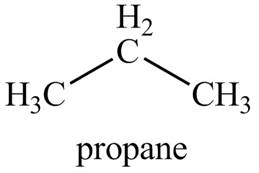
Figure 1
The given compound, propane shows two signals in
(b)
Interpretation: The number of
Concept introduction: The number of NMR signal in a compound is equal to the number of chemically non-equivalent protons present in that compound. Protons which are present in the same chemical environment that is between the same group of atoms are known as chemically equivalent protons and in
Answer to Problem 14.3P
The given compound, ethoxyethane shows two signals in
Explanation of Solution
The given compound is ethoxyethane that consists of two non-equivalent hydrogen groups. Therefore, the number of
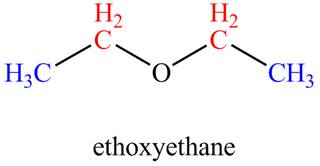
Figure 2
The given compound, ethoxyethane shows two signals in
(c)
Interpretation: The number of
Concept introduction: The number of NMR signal in a compound is equal to the number of chemically non-equivalent protons present in that compound. Protons which are present in the same chemical environment that is between the same group of atoms are known as chemically equivalent protons and in
Answer to Problem 14.3P
The given compound, butane shows two signals in
Explanation of Solution
The given compound is butane that consists of two non-equivalent hydrogen groups. Therefore, the number of
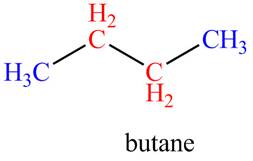
Figure 3
The given compound, butane shows two signals in
(d)
Interpretation: The number of
Concept introduction: The number of NMR signal in a compound is equal to the number of chemically non-equivalent protons present in that compound. Protons which are present in the same chemical environment that is between the same group of atoms are known as chemically equivalent protons and in
Answer to Problem 14.3P
The given compound,
Explanation of Solution
The given compound is
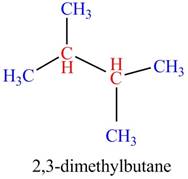
Figure 4
The given compound,
(e)
Interpretation: The number of
Concept introduction: The number of NMR signal in a compound is equal to the number of chemically non-equivalent protons present in that compound. Protons which are present in the same chemical environment that is between the same group of atoms are known as chemically equivalent protons and in
Answer to Problem 14.3P
The given compound, ethyl propanoate shows four signals in
Explanation of Solution
The given compound is ethyl propanoate that consists of four non-equivalent hydrogen groups. Therefore, the number of
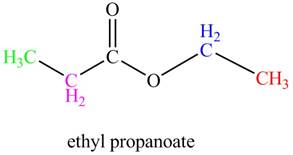
Figure 5
The given compound, ethyl propanoate shows four signals in
(f)
Interpretation: The number of
Concept introduction: The number of NMR signal in a compound is equal to the number of chemically non-equivalent protons present in that compound. Protons which are present in the same chemical environment that is between the same group of atoms are known as chemically equivalent protons and in
Answer to Problem 14.3P
The given compound,
Explanation of Solution
The given compound is
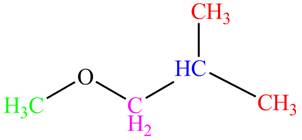
Figure 6
The given compound,
(g)
Interpretation: The number of
Concept introduction: The number of NMR signal in a compound is equal to the number of chemically non-equivalent protons present in that compound. Protons which are present in the same chemical environment that is between the same group of atoms are known as chemically equivalent protons and in
Answer to Problem 14.3P
The given compound,
Explanation of Solution
The given compound is
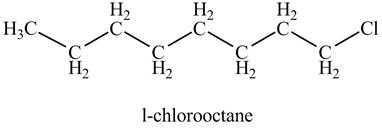
Figure 7
The given compound,
(h)
Interpretation: The number of
Concept introduction: The number of NMR signal in a compound is equal to the number of chemically non-equivalent protons present in that compound. Protons which are present in the same chemical environment that is between the same group of atoms are known as chemically equivalent protons and in
Answer to Problem 14.3P
The given compound,
Explanation of Solution
The given compound is
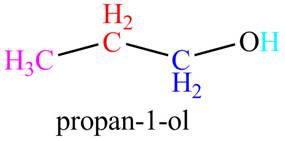
Figure 8
The given compound,
Want to see more full solutions like this?
Chapter 14 Solutions
ORGANIC CHEMISTRY
Additional Science Textbook Solutions
General, Organic, and Biological Chemistry - 4th edition
HUMAN ANATOMY
Campbell Biology: Concepts & Connections (9th Edition)
Organic Chemistry
Laboratory Manual For Human Anatomy & Physiology
- What is the relationship between the limiting reactant and theoretical yield of CO2?arrow_forwardFrom your calculations, which reaction experiment had closest to stoichiometric quantities? How many moles of NaHCO3 and HC2H3O2 were present in this reaction?arrow_forward18. Arrange the following carbocations in order of decreasing stability. 1 2 A 3124 B 4213 C 2431 D 1234 E 2134 SPL 3 4arrow_forward
- Acetic acid is added to DI water at an initial concentration of 10 -6 M (Ka=1.8x10-5) A. Using the "ICE" Method, what would the pH be at equilibrium? State assumptions and show your work. B. Using the simultaneous equations method, what would the pH be at equilibrium? Show your workarrow_forward1. Show that the change in entropy for a fixed amount of ideal gas held at a constant temperature undergoing a volume change is given by the simple equation AS = NkB In Hint: Start with the equation M dS = du + (Œ) dv - Ž (#) an, dU du+av-dN; j=1 Why doesn't the equation for the entropy of an ideal gas depend on the strength of the intermolecular forces for the gas?arrow_forward2. Make an ice cube at 1 bar pressure by freezing an amount of liquid water that is 2 cm x 2 cm x 2 cm in volume. The density of liquid water at 0 °C is 1.000 g cm³ and the density of ice at 0 °C is 0.915 g cm³. Note that this difference in density is the reason your water pipes burst if they freeze and why you shouldn't forget to take your bottle of pop out of the freezer if you put it in there to try and cool it down faster. A. What is the work of expansion upon freezing? B. Is work done on the system or by the system?arrow_forward
- I have a excitation/emission spectra of a quinine standard solution here, and I'm having trouble interpreting it. the red line is emission the blue line is excitation. i'm having trouble interpreting properly. just want to know if there is any evidence of raman or rayleigh peaks in the spectra.arrow_forwardGive the major product of the following reaction. excess 1. OH, H₂O 1.OH H CH3CH2CH21 H 2. A.-H₂O Draw the molecule on the canvas by choosing buttons from the Tools (for bonds), Atoms, and Advanced Template toolbars. The single bond is active by default.arrow_forward2. Use Hess's law to calculate the AH (in kJ) for: rxn CIF(g) + F2(g) → CIF 3 (1) using the following information: 2CIF(g) + O2(g) → Cl₂O(g) + OF 2(g) AH = 167.5 kJ ΔΗ 2F2 (g) + O2(g) → 2 OF 2(g) 2C1F3 (1) + 202(g) → Cl₂O(g) + 3 OF 2(g) о = = -43.5 kJ AH = 394.1kJarrow_forward
 EBK A SMALL SCALE APPROACH TO ORGANIC LChemistryISBN:9781305446021Author:LampmanPublisher:CENGAGE LEARNING - CONSIGNMENT
EBK A SMALL SCALE APPROACH TO ORGANIC LChemistryISBN:9781305446021Author:LampmanPublisher:CENGAGE LEARNING - CONSIGNMENT Organic Chemistry: A Guided InquiryChemistryISBN:9780618974122Author:Andrei StraumanisPublisher:Cengage Learning
Organic Chemistry: A Guided InquiryChemistryISBN:9780618974122Author:Andrei StraumanisPublisher:Cengage Learning


